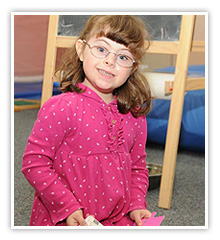
 Pediatric Occupational Therapy
Pediatric Occupational Therapy
Nassau County & Suffolk County - Long Island
 What is Pediatric Occupational Therapy?
What is Pediatric Occupational Therapy?
Occupational Therapy is a developmental intervention that enhances a child’s ability to successfully function within their environment, both at home and at school. In Early Intervention or a Preschool Special Education Program, Occupational Therapists work with children facing physical delays, educational delays, cognitive delays, self-care delays or sensory processing disorders that may affect their developmental performance.
Who are the Alternatives For Children Occupational Therapists?
Alternatives For Children’s Occupational Therapy staff is experienced with treating children with various disabilities including, but not limited to, Autism Spectrum Disorders, Cerebral Palsy, Down Syndrome, and ADHD. Children experiencing delays in sensory development, fine motor skills, visual perception, and visual motor skills benefit from the over 50 years of combined experience of our Occupational Therapists. Alternatives For Children’s Occupational Therapists are fully licensed by NYS.
What is the focus of Occupational Therapy?
Play - interacting with age-appropriate toys, games, equipment and activities.
Education - achieving in the learning environment.
Social Participation - developing appropriate relationships and engaging in behavior that doesn’t interfere with learning, self-help, self-care or social relationships.
Sensory Processing Integration - ability to process and respond to sensory information within the environment. Treatment usually consists of interventions that focus on providing the child with different sensory experiences and helping them become accustomed to those experiences.
Upper Body Development and Fine Motor Development - strengthen and refine motor development skills in order to access and manipulate various educational materials, toys, and objects encountered by the child during everyday activities.
What does an Occupational Therapist do?
A child’s “occupation” is play. To further skill development Occupational Therapists provide
fun and innovative age-appropriate activities to teach targeted skills in new ways.
Hands-on, open-ended and developmentally appropriate tasks to ensure attainment of Individualized Family Service Plan (IFSP) or Individualized Education Program (IEP) goals.
Opportunities to enhance the child’s abilities while considering accommodations in positioning, adaptive equipment, modification of the environment, strengthening, movement, sensory motor and motor planning issues.
My child seems to have poor fine motor skills. What can I do?
Nothing is more motivating to a child than toys and playing. The activities chosen should be experienced as fun. The child’s focus is on play, rather than on consciously “working” to improve a skill. Let your child play with play dough or silly putty. Practice cutting it with safety scissors or a plastic knife.
What is Sensory Integration (SI)?
All human beings receive information from their environment through the senses: vision, hearing, touch, taste, smell, and vestibular (movement) and proprioception (information from muscles and joints).
Sensory Integration is the ability to take in information from one’s own body and the environment, process the information, and respond functionally and appropriately. This process enables us to recognize, use and organize everyday sensory information in order to interact effectively with our environment. Sensory Integration is part of the foundation for learning and the acquisition and development of gross motor skills and fine motor skills, motor planning, attention, coordination and behavior.
My child displays decreased attention and hyperactivity. What can I do?
Movement and “heavy work”, the information the brain sends to muscles and joints, are very important experiences to the developing child. Make time for activities like swinging, sliding, riding the merry-go-round, push-pull games and jumping activities. Include in your family’s life, opportunities for sensory integration through time spent at children’s museums, bumper bowling, hiking, roller skating, bicycle riding, gymnastics and swimming.
Alternatives For Children provides spacious treatment areas with multi-sensory environments in our Therapeutic Sensory Motor Gyms. Our East Setauket and Dix Hills Centers house state of the art Sensory Rooms providing a dedicated space where external stimuli and the environment can be manipulated to intensify or reduce input according to a child’s therapeutic needs
Fine Motor Developmental Milestones
From 3 Months- Baby picks up rattle and moves it within 15 degrees
- Grasps a string to obtain a toy
- While lying on back the baby extends straight arms toward a rattle
- While lying on back the baby engages fingers in mutual touching
- The baby moves a rattle through a 90-degree arc
- Bangs a cup on the table
- Pokes finger in the hole of a pegboard
- Uses a raking motion to secure food pieces or uses his thumb against side of curled index finger to pick up food pieces
- The baby secures a string to retrieve an out of sight toy
- Bangs a cup on the table
- Removes both socks
- Places 3 to 7 blocks into a container
- Clap hands
- Grasps food pieces with the pad of thumb and pad of index finger with hand, wrist and arm off the table
- The baby stack 2 to 3 blocks
- Places 2 shapes into correct holes of a formboard
- Grasps marker or crayon with thumb and 1st finger toward paper and remaining fingers around marker
Home > Programs & Services > Pediatric Occupational Therapy in Suffolk County, New York

